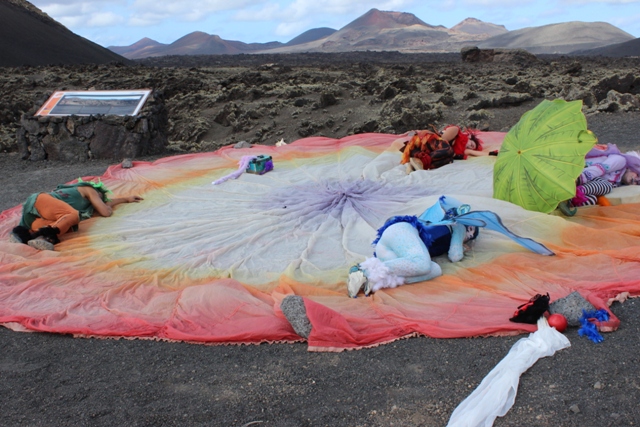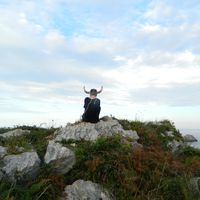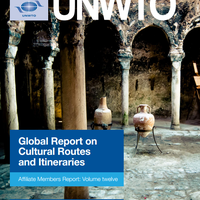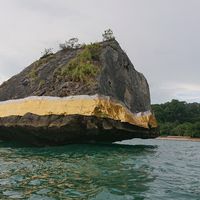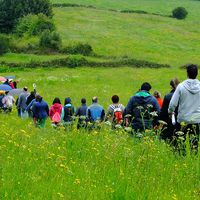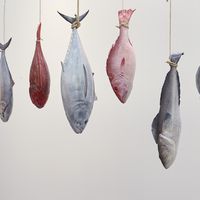Under the surface: Art interventions in coastal spaces

With a warming climate and the rise of sea levels, coastal spaces are a visual marker of our changing environment. However, there are many changes to coasts that are less visible, such as degradation to delicate ecologies or the declining health of the seawater. There are artists who are engaging directly with these themes, either through promoting a more sustainable tourism industry or through questioning what is happening to the coasts below the surface. This article takes a look at some of the festivals and artists working in this space and who promote more awareness of the way we take our coasts for granted.
Engaging tourists in debates of art and sustainability
Tourism is one of Spain’s most significant industries and helped to generate jobs in the recovery from the financial crisis. It accounts for about 11% of the GDP and is the world’s third most popular tourist destination, with more than 75 million tourists each year. The largest groups of tourists come from France, the UK, Germany and Italy, with the island of Tenerife and its famous Teide National Park attracting the highest number of visitors. Other attractions include the Mediterranean beaches, the religious centre of Santiago de Compostela and Sierra Nevada, the country’s most popular winter tourism destination.
This influx of tourism has an impact on the environment, especially through over-development in coastal areas that has led to degradation of beaches and coasts, as well as endangering fragile ecosystems in places like the Balearic Islands. These pressures on the environment will only increase with the impacts of climate change, as water levels rise and as summer heat waves of over 40 degrees Celsius become more common. In turn these changes are estimated to negatively impact the number of tourists Spain will receive, given that Spain’s tourism industry is heavily weather dependent.
Elvira Heras, the Director of Festival LANGAIA, notes that the context of sustainability is complex on Lanzarote Island in the Canary Islands. There are thousands of planes that arrive due to tourism, but it is also not feasible to simply cut off all tourism on the island, given it is one of its most significant industries. Heras observes that it can be a challenge to work in a context that receives a lot of tourists as there are two very distinct audiences the festival needs to target – the local community and tourists. Often visitors to Lanzarote Island don’t speak Spanish and are there for a break rather than to consider the environmental impacts of their travels. Festival LANGAIA endeavours to engage with a wide range of audiences through the fact that all their events are free and that they have a lot of activities in public spaces. This interactivity in unexpected places sparks the curiosity of the general public. In addition, the festival also engages with local hotels and tourist centres, placing music and artists in these spaces in order to reach out to tourists. This is a process that can take time, but there are now those working in the hotel industry who are more engaged in the festival and its themes of sustainability.
Another region that faces similar challenges as the Canary Island is the Balearic Islands in the Mediterranean. The festival Posidonia Mallorca: Festival Internacional de Arte, Naturaleza y Turismo Sostenible (International Ecofestival of Art, Nature & Sustainable Tourism) aims to address these issues in their May festival. Organised by Association Posidonia, which also organised similar festivals in Formentera (Balearic Islands), Carloforte and Tavolara (Sardinia), Sitges (Catalonia), Santa Margherita Ligure (Liguria) and Deià (Mallorca, Balearic Islands), Posidonia Mallorca promotes the protection of the oceans and the natural environment. It is significant that sustainable tourism is stated as a core part of the festival, and is one of the few festivals that integrate tourism so overtly in their vision.
Spain is by no means the only country impacted by mass tourism, but given the importance of the industry, it is an issue that is concerning many working in the nexus of art and sustainability.
Making visible the changing nature of coastal spaces
While the impact of mass tourism might leave an evident impact on coastal regions, there are other impacts that are less obvious. For the first Thailand Biennale in 2018-2019, French sound artist Félix Blume created Rumors from the sea, a site specific sound installation composed of hundreds of bamboo, usually used in Thailand as seawalls to slow coastal erosion, with a flute at their top. As the waves came in they played the bamboo flutes, creating music all day, its rhythm depending on the natural tide. The work, made in collaboration with the Bambugu builders and students from a local school, evoked a sea creature that spoke from beyond the waves, creating a voice from the depths for the public to hear. The work raised awareness about the voicelessness of nature and how it is often ignored and not listened to.
This work responded to a serious reality for the people living in the region, who have moved 5 times in the last 30 years because of coastal erosion. This is not the only case of displacement due to rising sea levels. A small fishing town near Bangkok called Ban Khun Samut Chin is disappearing under water as the coast encroaches one kilometre inland. The bamboo seawalls are no longer enough to keep back the rising sea.
In anther example of coastal changes, Singapore-based artist Charles Lim Yi Yong developed the work Sea State, which explored ‘perceptions of sea and land in the island city-state of Singapore’. The work drew from the World Meteorological Organization’s code for measuring sea conditions, bringing attention to the sometime extreme changes in the large bodies of water. Sea State was presented at the 56th Venice Biennale and portrayed the ways in which the ten-year project developed to include issues such as use of resources, climate change and concepts of territorial sovereignty. Land reclamation was a significant part of Charles Lim Yi Yong’s research, given that according to the UN Singapore is the biggest importer of sand, principally for land reclamation works. This has changed not only the physical space of the territory, but has also impacted the natural environment, with a reported 24 islands disappearing in the region due to the trade of sand.
Some coastal changes are not as evident to the casual observer. Australian artist Natalie Jeremijenko created a permanent public artwork that looked below the surface in order to monitor the health of an estuary through dissolved oxygen levels. The resulting work, Amphibious Architecture – What Does the Derwent Want?, installed 20 buoys in the bay at GASP (Glenorchy Art and Sculpture Park) that lit up in response to the condition of the water. This combination of science and art enabled audiences to see and experience the sometimes-invisible changes occurring in the environment and make the connection between these changes and the on-going health of an ecology before it’s too late.
These diverse projects that question the way we use coastal spaces are increasingly important in a context where water levels are rising and there coastal areas are being put under increasing pressure. Whether it’s through more sustainable tourism, or through making the environmental damage more visible to a wider audience, art has the capacity to step in and advocate for a change of attitudes towards our coastal spaces.
To read more about organisations working in the nexus of sustainability and creative practice, download the Creative Responses to Sustainability guides, published by culture360.ASEF.org since 2015:
- Spain Green Guide (2019)
- Portugal Green Guide (2019)
- Australia Green Guide (2018)
- Indonesia Green Guide (2017)
- Korea Green Guide (2016)
- Singapore Green Guide (2015)
Claire Rosslyn Wilson is a freelance cultural writer, researcher and poet, living between Barcelona and Melbourne. She has particular interests in cultural diversity, experiences of place and creative expression for social change. She co-wrote ‘Freelancing in the Creative Industries’ (Oxford University Press, 2015) and has over ten years professional experience in the arts and resource development.
Similar content
30 Sep 2019
posted on
24 Jan 2016
deadline
18 Aug 2017
deadline
01 Mar 2022

